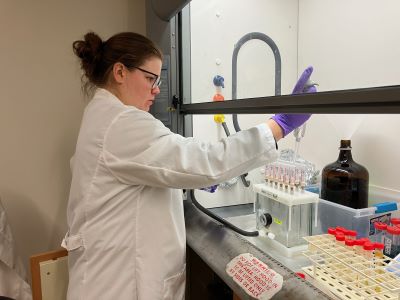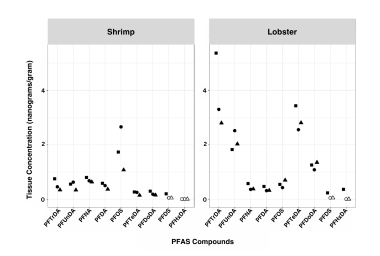Superfund Research Program
High Seafood Diet May Lead to Increased PFAS Exposure
Release Date: 06/05/2024
![]() subscribe/listen via iTunes, download(6.5MB), Transcript(67KB)
subscribe/listen via iTunes, download(6.5MB), Transcript(67KB)
A study funded by the NIEHS Superfund Research Program (SRP) found that consuming some types of commercial seafood in high quantities may increase the risk of PFAS exposure. Led by Celia Chen, Ph.D., Kate Crawford, Ph.D., and Megan Romano, Ph.D., at Dartmouth College, the research team believes their findings can support the development of consumption guidelines to protect communities from further PFAS exposure.
PFAS are a large class of synthetic chemicals widely used in commercial products. Exposure to PFAS is linked to certain cancers, impaired fetal development, thyroid and liver disorders, and other adverse health outcomes. In aquatic environments, PFAS can concentrate in the tissue of fish and shellfish, potentially exposing people to the chemicals via seafood consumption.
Seafood consumption guidelines are an important health tool used to alert the public about potentially hazardous contaminants in seafood. However, few consumption guidelines include recommendations for limiting PFAS exposure. To help inform guidelines, the Dartmouth team, with funding from an SRP Time-Sensitive Research Grant, sought to estimate PFAS exposure risk in New Hampshire from seafood.
Identifying Consumption Habits and PFAS Concentrations

First, researchers distributed a survey of seafood consumption habits to New Hampshire residents. The survey was used to document sociodemographic factors, how frequently people ate seafood, portion sizes, and the species of seafood consumed.
The team purchased the seafood species that people ate most according to the survey. These species included haddock, salmon, tuna, cod, shrimp, scallops, and lobsters. The seafood studied was purchased fresh from a market in coastal New Hampshire. Researchers analyzed each seafood sample for 26 different PFAS compounds.
Using mathematical equations, the researchers estimated participants’ daily PFAS ingestion rates — the amount of PFAS they consumed each day based on reported seafood consumption and PFAS concentrations detected in seafood species purchased. Then they used statistical analyses to compare PFAS ingestion rates to health guidance values set by public health agencies. Finally, the scientists calculated compound-specific hazard quotients, a ratio used to estimate whether exposure to a chemical may harm human health.
High PFAS Concentrations in Shellfish
The investigators found that adults and children in New Hampshire tend to eat more seafood than the national average. Shrimp, salmon, and haddock were the most frequently eaten species, followed by canned tuna, lobster, and scallops.

Scientists detected PFAS in all seafood samples, but they found the greatest number of individual PFAS compounds in shrimp and lobster, which tested positive for seven PFAS compounds.
Shrimp and lobster also had the highest concentrations of PFAS. Specifically, the team found high concentrations of a PFAS chemical that has been phased out of industrial use, commonly known as PFOS, and its replacement, called PFunDA, in shrimp and lobsters respectively.
Analysis of calculated hazard quotients revealed that average consumers of shrimp and lobster were not at high risk of negative health effects from PFAS exposure via seafood. However, among high seafood consumers, PFOS in shrimp and PFUnDA in lobster had high hazard quotients, meaning that they may pose a health risk to both adults and children.
Because seafood is an important source of nutrition and cultural heritage for communities across the U.S. and globally, it is necessary to appropriately assess PFAS exposure from seafood, the authors noted. This study suggests that commercially consumed seafood should be considered a source of PFAS exposure when developing seafood consumption guidelines, they added.
For More Information Contact:
Celia Y Chen
Dartmouth College
Department of Biological Sciences
Class of '78 Life Sciences Center, Room 126
Hanover, New Hampshire 03755-3576
Phone: 603-646-2376
Email: celia.y.chen@dartmouth.edu
To learn more about this research, please refer to the following sources:
- Crawford KA, Gallagher L, Giffard NG, Gardiner C, Holsen TM, Chen CY, Romano M. 2024. Patterns of Seafood Consumption Among New Hampshire Residents Suggest Potential Exposure to Per- and Polyfluoroalkyl Substances. Expo Health doi:10.1007/s12403-024-00640-w (in press)
To receive monthly mailings of the Research Briefs, send your email address to srpinfo@niehs.nih.gov.


